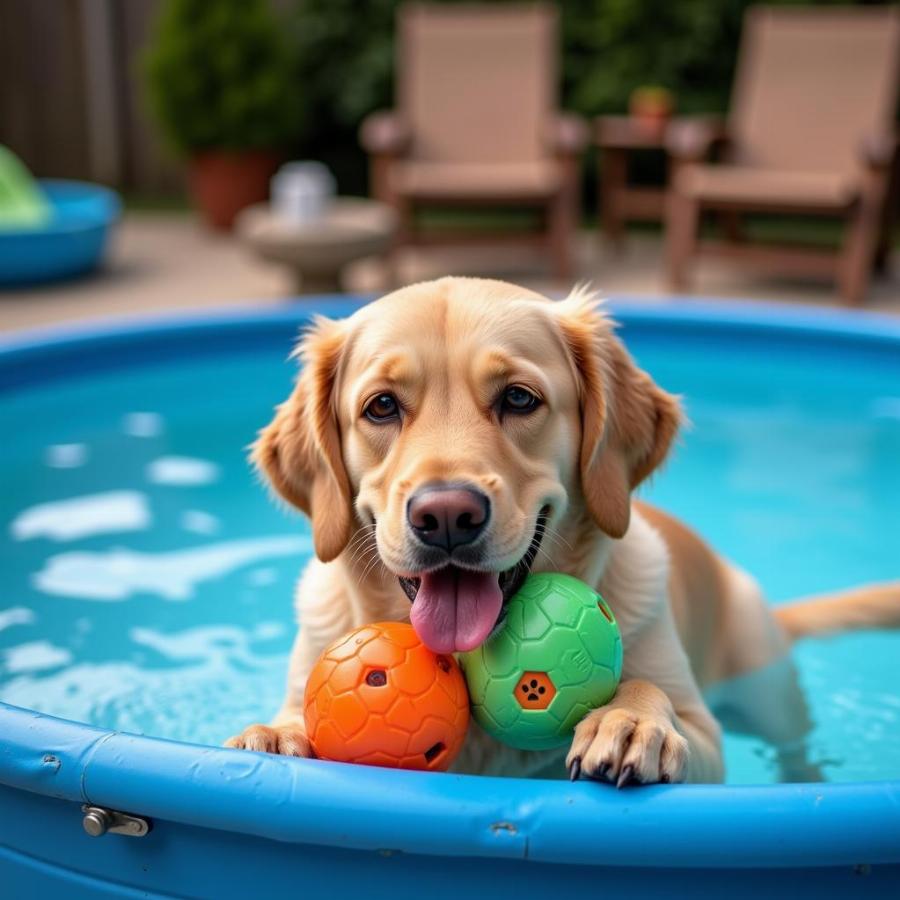Big dog swimming pools offer a fantastic way for your furry friend to cool off, exercise, and have a blast, especially during those hot summer months. But choosing the right pool and ensuring your dog’s safety requires careful consideration. This article dives deep into everything you need to know about big dog swimming pools, from selecting the perfect size and material to essential safety tips and maintenance advice.
Choosing the Right Big Dog Swimming Pool
What kind of pool is best for a big dog? There are various types of big dog swimming pools available, each with its own pros and cons. Hard plastic pools are durable and easy to clean, while foldable fabric pools are portable and convenient for storage. Consider your dog’s size, activity level, and your available space when making your choice. For giant breeds, a larger, more robust pool is essential. If you have limited space, a dog daycare williamsburg va might be a better option for your dog’s swimming needs.
Size and Material Matters
The size of your big dog swimming pool should comfortably accommodate your dog’s length and allow for ample movement. Measure your dog from nose to tail and add a few extra feet to ensure a comfortable swimming experience. The material should be durable and non-toxic, resistant to punctures and tears from enthusiastic paws and claws.
There are several durable materials on the market today from hard plastic to heavy-duty PVC. Be sure to do your research and choose the best material for your dog’s temperament and your budget.
Essential Safety Tips for Big Dog Swimming Pools
Safety is paramount when it comes to big dog swimming pools. Never leave your dog unsupervised in the pool, even for a short period. Always provide fresh drinking water nearby to prevent dehydration. Introduce your dog to the pool gradually, allowing them to acclimate to the water at their own pace.
Supervision and Gradual Introduction
Just like children, dogs need constant supervision around water. Even strong swimmers can get into trouble. Start by letting your dog explore the empty pool, then gradually introduce water, rewarding calm behavior. If your dog shows anxiety about the water, don’t force them in.
Pool Maintenance for a Healthy Swim
Regular cleaning is essential to prevent the buildup of algae, bacteria, and debris. Drain and refill the pool regularly, and use a pet-safe cleaner to scrub the surfaces. Proper maintenance ensures a healthy and enjoyable swimming experience for your furry friend. Think of it like maintaining a clean environment for them like at a reputable dog boarding newnan ga.
FAQs: Your Big Dog Swimming Pool Questions Answered
Here are some common questions about big dog swimming pools:
- What are the benefits of a dog swimming pool? Swimming provides low-impact exercise, helps dogs cool down in hot weather, and can be a fun and enriching activity.
- How often should I clean my dog’s pool? Ideally, you should clean the pool after each use. For less frequent use, aim to clean it at least once a week.
- Can I use chlorine in my dog’s pool? While small amounts of chlorine are generally safe, it’s best to use a pet-safe pool cleaner to avoid skin and eye irritation.
- What’s the best location for a dog swimming pool? Choose a level, shaded area in your yard to prevent overheating and minimize algae growth.
- My dog is afraid of water. How can I encourage them to use the pool? Use positive reinforcement, treats, and toys to coax your dog into the pool gradually. Never force them.
- Are there any specific breeds that benefit more from swimming? Breeds prone to hip dysplasia or other joint issues can benefit greatly from the low-impact exercise provided by swimming. However, all breeds can enjoy a refreshing dip!
- What should I do if my dog ingests pool water? While small amounts are usually harmless, excessive ingestion can lead to vomiting or diarrhea. Consult your veterinarian if you’re concerned.
Further Questions?
Still have questions about big dog swimming pools? Check out these related resources:
- Dog Pool Accessories: Explore toys, floats, and ramps to enhance your dog’s pool experience.
- Dog Water Safety Tips: Learn essential safety guidelines for keeping your dog safe around water.
Expert Advice
Dr. Emily Carter, a renowned veterinary specialist in canine hydrotherapy, advises, “Swimming is a fantastic form of exercise for dogs, especially for those with mobility issues. It’s crucial, however, to ensure proper supervision and gradual introduction to the water.”
Another expert, certified dog trainer Mark Johnson, adds, “Positive reinforcement is key when introducing a dog to swimming. Make it a fun and rewarding experience with praise, treats, and favorite toys.”
Conclusion
Big dog swimming pools provide a wonderful opportunity for your canine companion to beat the heat, stay active, and have a splashing good time. By choosing the right pool, prioritizing safety, and maintaining it properly, you can ensure a safe and enjoyable swimming experience for your furry friend. Remember to always supervise your dog while swimming and introduce them to the water gradually.
 A Happy Dog Enjoying Their Pool with Toys
A Happy Dog Enjoying Their Pool with Toys
Beaut Dogs is your trusted source for all things dog-related. We provide expert advice on everything from choosing the right breed to providing the best care. For personalized guidance and answers to your specific questions, contact us at [email protected]. Beaut Dogs is here to help you navigate the wonderful world of dog ownership. Visit us at https://beautdogs.com.